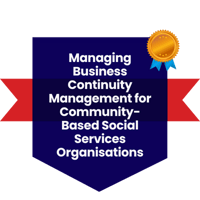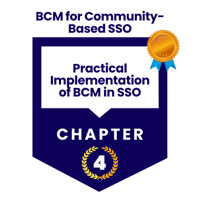Chapter 6
Governance and Sustainability in Business Continuity Management
![[BCM] [SSO] [C6] Governance and Sustainability in BCM](https://no-cache.hubspot.com/cta/default/3893111/fc72acdb-d95e-4823-b7bf-27ce15cc7542.png) Sustaining a Business Continuity Management (BCM) program requires more than a plan on paper — it requires strong governance, active leadership, and a culture of preparedness that reaches every level of the organisation.
Sustaining a Business Continuity Management (BCM) program requires more than a plan on paper — it requires strong governance, active leadership, and a culture of preparedness that reaches every level of the organisation.
For social service organisations in Singapore, this governance is not only about operational efficiency; it is about accountability to the children, youth, and families who depend on uninterrupted care.
This chapter explores how governance structures, leadership commitment, and continuous improvement can ensure that BCM remains sustainable over time.
Role of the Board, Senior Management, and Staff
Effective BCM starts with clear roles and shared ownership across the organisation.
The Board of Directors
The board provides strategic oversight and accountability. Its role is to ensure that the organisation has a functioning continuity framework aligned with its mission and risk appetite.
Key responsibilities include:
- Endorsing BCM policies and objectives.
- Ensuring BCM is resourced adequately.
- Reviewing major risk exposures and recovery capabilities.
- Holding management accountable for maintaining resilience.
A board that understands BCM sees it as a governance tool, not just an operational activity.
Senior Management
Senior leaders are responsible for implementing BCM and integrating it into day-to-day operations. Their commitment determines whether BCM thrives or fades after initial setup.
They should:
- Assign clear roles for continuity planning.
- Champion staff participation in risk assessments and exercises.
- Communicate the value of preparedness during meetings and briefings.
- Lead by example during drills and crisis responses.
Strong leadership sets the tone — if management treats BCM seriously, staff will follow suit.
Staff at All Levels
Frontline caregivers, social workers, therapists, and administrative personnel all play a role in continuity.
Their practical knowledge of daily operations makes them essential contributors to the BCM process — especially in identifying critical services and workable recovery strategies.
Staff should be trained and empowered to:
- Recognise potential risks in their areas.
- Follow crisis response procedures confidently.
- Participate actively in debriefs and lessons learned after incidents.
Reporting to Regulators, Funders, and Donors on Resilience
Transparency is a cornerstone of sustainability. Social service organisations rely on public trust and financial accountability, so communicating BCM achievements reinforces credibility.
Regulators
For organisations funded or overseen by government agencies (e.g., NCSS, MSF), regular BCM reporting demonstrates compliance with service continuity and safety standards. This may include exercise reports, risk assessments, and incident reviews.
Funders and Donors
Donors want assurance that their contributions are protected and that services will continue during disruptions. Including a short BCM statement in annual reports — highlighting drills, training, and resilience milestones — reassures funders that their support is being used responsibly.
Community and Partners
Sharing continuity success stories — for example, how an organisation maintained therapy services during a power outage — strengthens community confidence and encourages collaboration across the social service network.
Building BCM into Daily Culture and Training
A BCM plan is only effective when it is embedded in the organisational culture. This means turning continuity planning into a natural part of how people think and work every day.
Practical Steps to Build a BCM Culture
- Onboarding: Introduce BCM awareness in new staff orientation programs.
- Training: Include short refresher sessions during team meetings or annual retreats.
- Visual Reminders: Display emergency contact charts, evacuation maps, and BCM flow diagrams in key areas.
- Empowerment: Encourage staff to raise “what if” questions and propose improvement ideas.
- Leadership Messaging: Have senior leaders regularly emphasise the importance of preparedness.
When BCM becomes part of daily behaviour, it evolves from a project into a shared mindset — creating a resilient and confident workforce ready to face uncertainty.
Continuous Improvement: Review After Exercises and Real Incidents
Resilience is a journey, not a destination. Every exercise and real-life incident offers a learning opportunity to refine plans and strengthen responses.
After Each Exercise
- Conduct structured debriefs to capture what worked well and what didn’t.
- Update procedures, contact lists, and training materials accordingly.
- Share lessons learned across departments and partner organisations.
After Real Incidents
- Perform a post-incident review focusing on root causes, communication effectiveness, and recovery timelines.
- Recognise staff contributions and provide emotional support if needed.
- Use findings to revise the BCM plan and report improvements to stakeholders.
A commitment to continuous review ensures the BCM program remains relevant, practical, and aligned with changing circumstances — from new technologies to emerging risks such as cyber threats and pandemics.
Sustaining Resilience for the Long Term
Governance and sustainability in BCM are ultimately about institutionalising resilience.
When the board leads, management empowers, and staff participate, the organisation builds a culture that endures beyond any single disruption.
For social service organisations, the ultimate goal is clear: To protect the vulnerable, maintain trust, and ensure that care continues — no matter what challenges arise.
A well-governed and continuously improved BCM program is not just a compliance exercise. It is a statement of commitment, compassion, and responsibility to those who depend most on the organisation’s services.
More Information About Business Continuity Management Courses

 To learn more about the course and schedule, click the buttons below for the BCM-300 Business Continuity Management Implementer [B-3] course and the BCM-5000 Business Continuity Management Expert Implementer [B-5].
To learn more about the course and schedule, click the buttons below for the BCM-300 Business Continuity Management Implementer [B-3] course and the BCM-5000 Business Continuity Management Expert Implementer [B-5].
![Register [BL-B-3]*](https://no-cache.hubspot.com/cta/default/3893111/ac6cf073-4cdd-4541-91ed-889f731d5076.png) |
 |
 |
 |
 |
 |
![FAQ [BL-B-3]](https://no-cache.hubspot.com/cta/default/3893111/b3824ba1-7aa1-4eb6-bef8-94f57121c5ae.png) |
If you have any questions, click to contact us.
|
 |
 |
 |
 |





![[BCM] [SSO] [C1] BCM for Community-Based Social Services Organisations](https://no-cache.hubspot.com/cta/default/3893111/abcc60b1-a41a-47de-b0d5-84644744d776.png)
![[BCM] [SSO] [C2] Understanding BCM in Social Service Organisations](https://no-cache.hubspot.com/cta/default/3893111/8dbf8f0f-371f-437c-a7d7-ccaff00b9433.png)
![[BCM] [SSO] [C3] Building a Practical BCM Framework for Social Service Organisations](https://no-cache.hubspot.com/cta/default/3893111/879387df-1aee-4517-8d38-fa33138b82ab.png)

![[BCM] [SSO] [C5] Case Study – Fire in a Residential Care Facility](https://no-cache.hubspot.com/cta/default/3893111/f18526eb-1b38-42a2-9c7d-52afe2121435.png)
![[BCM] [SSO] [C7] Conclusion – Building a Culture of Care and Continuity](https://no-cache.hubspot.com/cta/default/3893111/b5cd16e6-e11f-4b42-8349-e043bab8187e.png)
![Email to Sales Team [BCM Institute]](https://no-cache.hubspot.com/cta/default/3893111/3c53daeb-2836-4843-b0e0-645baee2ab9e.png)

